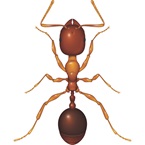Black Meat Ant - How to get rid of Black Meat Ants - Black Meat Ants are common in Australia
- Classification
Species category: Ant
Latin Name: Iridomyrmex spp.
- Description
The Black Meat Ant very similar to the Meat Ant but considerably smaller in size, reaching 4-5mm in length. Typically black in colour, its compound eyes are located high on the head away from its strong mandibles and they have a single prominent node on pedicel.
- Behaviour:
Generally omnivores, they can eat proteins and will occasionally eat sugars from natural sources. They are excellent scavengers.
Usually found close to, or connected to, an easily recognisable nest thanks to the presence of debris to cover up the opening of the nest. They can be aggressive and will go to great lengths to protect the nest from intruders. Yet, they do not have a sting and instead attack with their strong mandibles.
Region:
They are very common and distributed widely throughout Australia.
Habitat:
Underground nest dwellers, this ant species is known to create ‘super-colonies’ which occur when a queen and a number of its nest sharing ants, leave the original nest and start a new colony in close proximity, this process is called budding.
The ‘super-colony’ can have an extraordinarily large population that reaches tens of thousands of ants. Each nest in the ‘super-colony is linked through a series of trails and pathways.
- Risks:
More of a nuisance than a pest, they can create large colonies in the soil which can displace turf and destabilize paving. They do not have a sting but can attack with their large biting jaws and will do so en masse which can be intimidating for the victim.
They also excrete a pungent odour which can be strong when involved with a mass infestation.
Envu recommends using Maxforce Quantum liquid ant bait.

